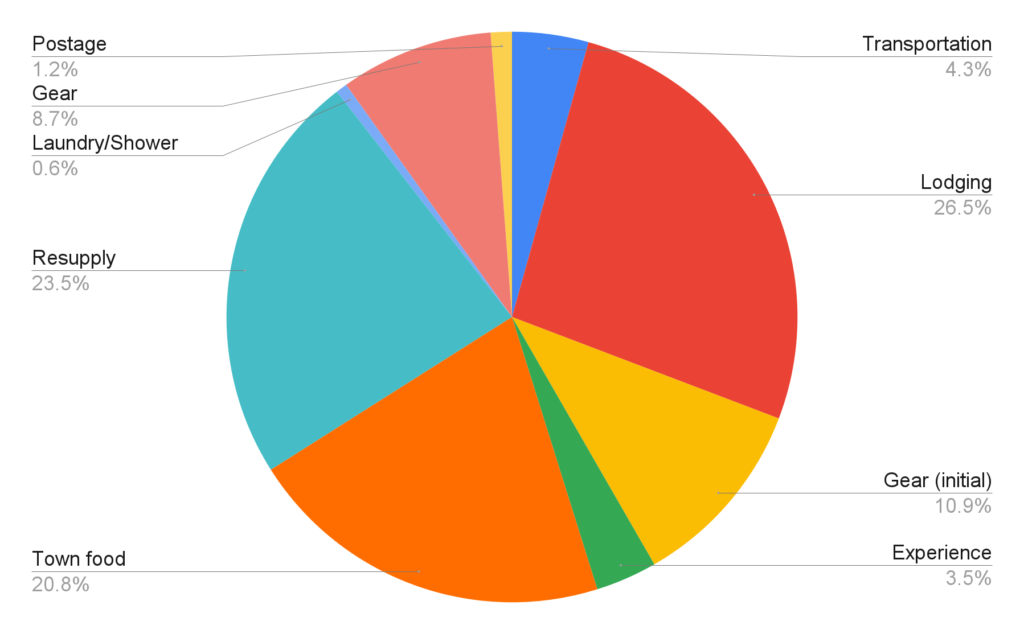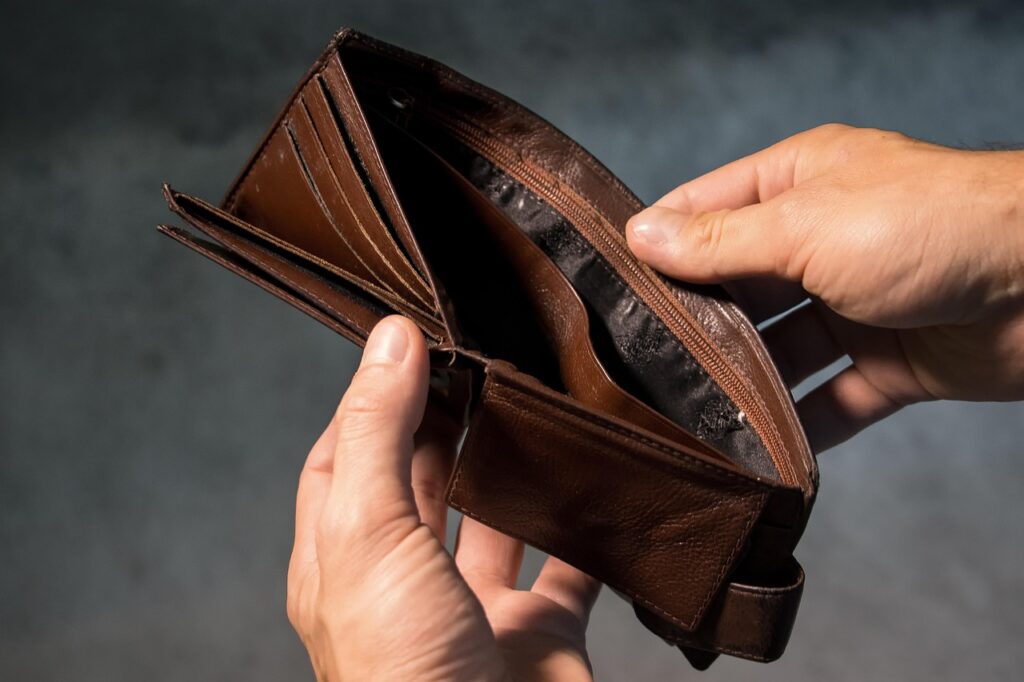I tracked every dollar I spent on the Appalachian Trail.
I did this from a curiosity standpoint; I was interested to know what the final figure would be. Though I had an approximate idea on how much I thought the hike might cost, I did not set an exact budget. My goal was to make frugal decisions wherever possible, but not to the point where it would affect my overall enjoyment of the experience.
I recorded my spending on a note on my phone after each purchase, though I did not keep a running total. (I just added up total cost today). I didn’t want to worry about the figure while hiking, I just wanted to be able to know what I had spent after the fact.
On the other hand, I do suspect that on some level, having to write down every purchase may have subconsciously discouraged me from superfluous spending, similar to how it is known that tracking your calorie intake leads to eating less calories. It keeps you honest.
Each expense was classified into one of 9 categories. Here are the results.
Transportation: $254.74
- Getting to Georgia and getting home from Maine
- Shuttles to/from the trail
Lodging: $1560.76
- Hotels
- Hostels
- Paid campsites
Gear (initial): $643.03
- Gear purchased before start of trip
Gear: $511.25
- Gear replacements purchased during the trip
Town food: $1228.78
- Any food not packed in my backpack
- Restaurants
- Vending machines
- Gas station treats
- Beer/alcohol
- Coffee, soda, etc.
Resupply: $1384.49
- All food eaten on the trail (non town food)
- Other consumables such as sunscreen, bug spray, toilet paper, etc.
Laundry/Shower: $38.00
- Laundromats
- Laundry fees at hotels/hostels
- Paid showers
Postage: $70.65
- Resupply boxes sent from home
- Postcards and cards
- Unneeded gear sent home
Experience: $205.00
- Miscellaneous expenses that contributed to the overall experience: aqua blazing fees, Smoky National Park permit, Trail Days admission
TOTAL: $5,896.70

$5,896.70 over 164 days and 2198.4 miles. That’s $36/day, or $2.68/mile.
Is that a lot?
Compared to other hikers
I believe the cost of a thru-hike varies wildly from person to person. Just like in real life, spending habits and priorities are extremely dependent on the individual.
In 1970, Branley Owen set a speed record for the Appalachian Trail, completing the hike in only 73 days. His pace was certainly impressive, but perhaps even more impressive was his budget. He claimed to hike the entire trail for $40. In today’s dollars, that would be $315, an unbelievably low figure.
In contrast, in Georgia I met a former thru-hiker who, shortly before he was to begin in 2018, received a gift from a family friend to fund his hike. Adding the gift to the money he had already saved, he now had a total of $15,000. He spent every penny.
When I was planning my hike, a general rule of thumb I heard was to allot about $1000 a month. That rule has been around for a while though, and given recent inflation, I also heard that $1500 a month was probably more accurate.
Notice that this estimate is given in time (months) and not in miles. Probably the biggest factor that affects the cost of a thru-hike is your pace. The more days you spend on the trail, the more expensive your hike will be. Some people can complete the trail in as little as 4 months, while some take 7 or more. At 5 1/2 months, my pace was about average.
With $5,900 over 5 1/2 months, I’d say that for me, the conventional $1000/month rule was pretty spot on. I don’t know what other 2023 AT thru-hikers spent and it’s probably impolite to ask, but because I generally made frugal decisions, my guess is that my total cost was less than average.
My cost savers
- Flights. Both of my flights were booked with travel reward points, so I spend $0 on flights. Depending on where you’re traveling from, the cost to get to and from the trail could get quite expensive.
- Nearos over zeros. Zeros are expensive. To be able to hike 0 miles in a day, you must spend two nights in town, meaning more lodging and restaurant costs. In the second half of my hike, I took very few true zeros, favoring nearos instead. I found that this was both better for my wallet and for my body. I learned that for me, a series of medium-mile days followed by a nearo, was better than a series of high mile days followed by a zero.
- Gear. I was fortunate to already have most of the gear I needed from previous hikes. If I had to start from scratch, my total cost would have easily increased by $1000 or so.
- Scavenging. It is common for outfitters and hiker hostels to have “hiker boxes,” where hikers donate their unwanted gear or food for other hikers to take for free. I learned to always check the hiker box before I went shopping. I could often get a decent portion of my resupply from the hiker box.
Compared to real life
$6K is nothing to scoff at, but in the grand scheme of things, I think this was quite a low cost for my adventure of a lifetime.
I lived in the richest country in the world for $36 a day. I think that would be very very hard to do outside of thru-hiking.
Now, I personally did have other real-life bills on top of that – mortgage, utilities, insurance, etc., but imagine that you didn’t. Say you were a recent college grad and you just ended your apartment lease and sold your car. Or maybe you’re a recent divorcee ready for a mid-life change so you sell your house and all your belongings. Then $36 a day could cover basically all of your living expenses, except for health insurance, your cell phone bill, and maybe a Spotify account to listen to music while hiking.
Worth every penny
I know this is money very well spent. Every dollar was an investment in unforgettable experiences, personal growth, and cherished memories.



“I lived in the richest country in the world for $36 a day. I think that would be very very hard to do outside of thru-hiking.” Just out of curiosity, I measured how much someone would make working 40 hours a week at minimum wage for 164 days. $6,794.28 or $41.42 per day. At this income, federal income tax + social security = approx 9% of income, reducing the take home to $37.90 per day (not counting any state income tax). As you note, $36 per day did not cover health insurance, cell phone, or other basic life bills. Yikes.
Wow, thanks for sharing that. I hadn’t considered it as a lesson in minimum wage issues, but those figures are certainly illuminating! I also was only supporting myself on the hike (no kids, pets, or other dependents).